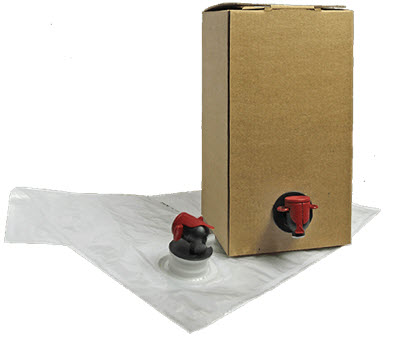A bag-in-a-box (BiB) container consists of two main components: the bag and the box. It is used for storing and transporting liquids.
- The bag, also known as the bladder, is typically made from several layers of metallised film or other plastics.
- The box is usually a corrugated fibreboard box.
The first commercial bag-in-a-box system was created by William R. Scholle in 1955. Scholle’s bag-in-a-box packaging was used to store, transport and dispense battery acid in a safe manner. For his invention, Scholle was inducted into the Packaging Hall of Fame in 1991.
Advantages
- Compared to many other types of packaging offering the same level of food safety, the bag-in-a-box is inexpensive.
- Since the plastic bag is stored inside a rigid box, a light and comparatively flimsy plastic material can be utilised. From an environmental perspective, this can make the bag-in-a-box superior to rigid plastic packaging alternatives.
- Compared to bottles, round jars and similar, straight-sided bag-in-a-box packaging is more efficient when it comes to transportation since the boxes can be stacked neatly together without any leftover space in between.
- Although most consumers only encounter bag-in-a-box products containing 3 litres of liquid or less, really large bag-in-a-box products are available for the B2B market, including bag-in-a-box packaging capable of holding 1,000 litres or more. (One 1,000 litres equals 1 cubic metre.)
Uses
The bag-in-a-box solution is used for the storing, transporting and dispensing of many different products, among which of the most well-known are wine, liquid dairy products and liquid fruit products (such as fruit juice). Syrup for soft drink fountains is also often sold in bag-in-a-box packaging. In the food service industry (especially in fast food outlets), bag-in-a-box packaging is used to store and dispense bulk supplied condiments such as ketchup and mustard.
As mentioned above, William R. Scholle’s commercial bag-in-a-box system was created for battery acid. This usage is not a thing of the past and bag-in-a-box technology is still utilised to hold, transport and dispense sulphuric acid for filling lead-acid batteries in garages, dealerships and similar.
Bag-in-a-box technology is used extensively for the packaging of products that needs to be aseptic, i.e. free from potentially disease-causing micro-organisms such as pathogenic bacteria, viruses, fungi and parasites.
BiB wine
Since virtually all modern bag-in-a-box solutions for wine comes with (an almost) air-tight tap, you can pour some of the wine out without exposing the remaining wine to a lot of air. This prevents oxidation of the remaining wine, which means that you can keep it in the container for quite a long time before it spoils compared to wine in an opened traditional wine bottle. Also, BiB wine is not subjected to cork taint.
It should be noted that some oxygen can transmit through the film and tap even before you have opened the tap for the first time. The rate of transmission depends largely on the type of plastic used. Because of this, many BiB wines have a shorter shelf-life than glass bottled wine. Consult the best-before date stamped on the BiB for more information. BiB wines are not intended for cellaring.
History
The Angove wine cask
In 1965, the Australian winemaker Angove was granted a patent for their wine cask. The Angove wine cask, invented by Thomas Angove (1918-2010), consisted of a 1 gallon polyethylene bladder placed inside a corrugated box. This product was intended for sale to consumers.
With the early designs, the end-user had to manually cut a corner of the bladder inside the box, pour out the desired quantity of wine and then reseal the corner using a special peg.
The tap
In 1967, pouring wine from a bag-in-a-box became significantly more convenient as Charles Malpas and Penfolds Wines patented a plastic, air-tight tap welded into a metallised film bladder.
Today, virtually all bag-in-a-box wine products come with some type of plastic tap. Typically, the end-user will expose the tap by tearing away a perforated panel on the box.
